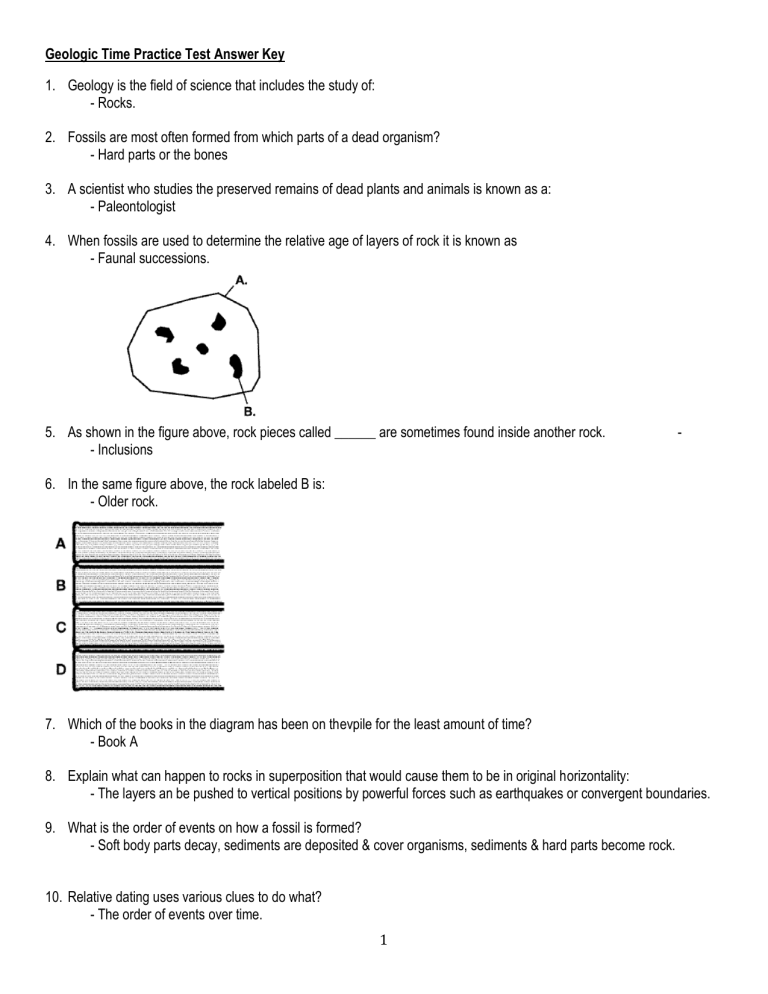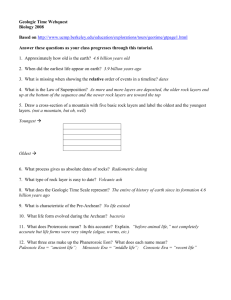Geologic Time Practice Test Answer Key

Geologic Time Practice Test Answer Key
1.
Geology is the field of science that includes the study of:
- Rocks.
2.
Fossils are most often formed from which parts of a dead organism?
- Hard parts or the bones
3.
A scientist who studies the preserved remains of dead plants and animals is known as a:
- Paleontologist
4.
When fossils are used to determine the relative age of layers of rock it is known as
- Faunal successions.
5.
As shown in the figure above, rock pieces called ______ are sometimes found inside another rock.
- Inclusions
6.
In the same figure above, the rock labeled B is:
- Older rock.
-
7.
Which of the books in the diagram has been on thevpile for the least amount of time?
- Book A
8.
Explain what can happen to rocks in superposition that would cause them to be in original horizontality:
- The layers an be pushed to vertical positions by powerful forces such as earthquakes or convergent boundaries.
9.
What is the order of events on how a fossil is formed?
- Soft body parts decay, sediments are deposited & cover organisms, sediments & hard parts become rock.
10.
Relative dating uses various clues to do what?
- The order of events over time.
1
11.
The fact that the layers of rock on one side of the Grand Canyon match up with the layers on the other side of the
Grand Canyon illustrates what principle of relative dating?
- Lateral continuity
12.
The theory of cross-cutting relationships states that a vein of rock that cuts across a rock’s layers is:
- Younger than the rock layers.
13.
The law that states that the bottom layer of a rock formation is older than the layer on top is known as:
- The law of superposition.
14.
The change in position of rock layers shown in the illustration demonstrates the theory of:
- Original horizontality.
15.
Several different layers of rock were found tilted at an angle of 70 from the horizontal. What probably caused this 70 tilt?
- These layers changed position due to geologic movement like and earthquake or convergent boundary.
16.
In the geologic time scale, major period of time are divided into:
- Eras, and periods.
17.
The longest division of time on the geologic time scale are known as:
- Eras.
18.
What types of organisms lived on Earth during the Precambrian Era?
- Single-celled organisms.
19.
Mesozoic means:
- “Middle life”
-
20.
Toward the end of the Paleozoic era, much of the land was covered with?
- Palm Trees and giant ferns also known as Early Glossopteris Flora
21.
A large meteor may have hit Earth and caused the extinction of dinosaurs and many plant species during the:
- Mesozoic Era.
22.
The Cenozoic Era is referred to as:
- “Recent life”
23.
A method of estimating the age of a rock sample in years is called:
- Absolute Dating.
- - -
2
24.
According to the geologic time scale, in which era did humans first appear?
- Cenozoic Era.
25.
Scientists have used radioactive decay to estimate that Earth is how old:
- 4.6 billion years old.
26.
Millions of years ago, the continents were once a great landmass that was named?
- Pangaea.
27.
What explains why the same types of fossils are found spread on different continents?
- The separation and movement of Pangaea into today’s continents.
28.
______ From the figure above, humans and mammals first appears in the era labeled A what is the name of era A?
- Cenozoic Era.
29.
______ From the figure above, dinosaurs, birds, and flowering plans first appeared during the era labeled B, What is the name of era B?
- Mesozoic Era.
30.
______ From the figure above, fish and plants first appeared during the era labeled C. What is the name of era C?
- Paleozoic Era.
3
Please complete the following prompts and questions by writing out your answers as completely as possible
31.
Explain how relative dating of fossils differs from absolute dating of fossils.
Relative dating is when geologists use clues in rock to explain how the landform has changed over time. Relative
Dating focuses on the sequence of events, NOT the actual age of the rock. Whereas, absolute dating is a process where geologists try to determine the actual age of a rock.
32.
Rocks A, B, and C are layers of sedimentary rocks. Rock D is a rock intrusion. Which rock is oldest? Which rock is youngest? Explain how you know using the terms superposition and cross cutting relationships.
Looking at this rock cross section the correct sequence of events would be:
1. Layer C is formed
2. Layer B is formed
3. Layer A is formed
4. The Intrusion D is formed.
The way that we know this is that sediments are deposited in horizontal layers. Over time, through compaction and cementation those layers form into solid rock. Geologists refer to this as Superposition, which states that the bottom layer of a rock formation is older than the layer on top, because the bottom formed first. However changes can happen to those layers of sedimentary rock. In this specific example we see an intrusion in the layers which geologists refer to as a cross cutting relationship. Cross cutting relationships states that a vein of rock that cuts across a rocks layers is younger than the layers. The vein formed when molten rock oozed into a crack in the original layers, cutting across the rock.
33.
Explain how the ancient plant species Glossopteris gives evidence for Pangaea.
Glossopteris was able to thrive on all continents nearly 250 million years ago when the continents were all connected and had similar climates. As continents moved, climates changed and Glossopteris wasn’t able to grow on every continent like it previously did.
4






